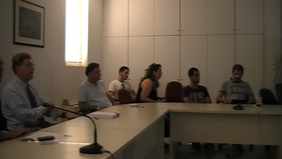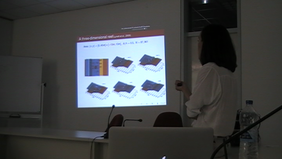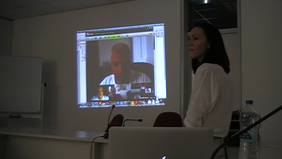Θέμα διδακτορικής διατριβής: "Μαθηματική και υπολογιστική μοντελοποίηση γένεσης και διάδοσης κυματισμών στο θαλάσσιο και παράκτιο περιβάλλον"("Mathematical and computational modeling for the generation and propagation of waves in marine and coastal environments")
Παρουσίαση: 27 Σεπτεμβρίου 2013, ώρα 15.00, αίθουσα Συνεδριάσεων ΜΗΠΕΡ, Σχολή Μηχανικών Περιβάλλοντος, Πολυτεχνειούπολη.
Εξεταστική Επιτροπή:
Καθηγητής Κώστας Συνολάκης, Επιβλέπων
Αναπληρωτής Καθηγητής Ανάργυρος Δελής, μέλος τριμελούς συμβουλευτικής επιτροπής
Ερευνητής Α’ Νικόλαος Καμπάνης, μέλος τριμεούς συμβουλευτικής επιτροπής
Καθηγητής Ιωάννης Σαριδάκης
Αναπληρωτής Καθηγητής Δημήτρης Γκούσης (ΕΜΠ)
Καθηγητής Βασίλειος Δουγαλής (ΕΚΠΑ)
Professor Frederic Dias (University College Dublin)
Περίληψη
Στο ϑαλάσσιο περιβάλλον εξελίσσεται ταυτόχρονα ένα πλήθος κυµατικών ϕαινοµένων, αρκετά από τα οποία βρίσκονται σε ουσιώδη σύζευξη µεταξύ τους. Η προσοµοίωση της γένεσης και διάδοσης των κυµατισµών και η ακριβής περιγραφή των µετασχηµατισµών που υφίστανται στις παράκτιες περιοχές είναι απαραίτητη σε σχέση µε τον σχεδιασµό των ϑαλάσσιων κατασκευών, την ασφάλεια καθώς και την πρόβλεψη της εξέλιξης του προφίλ της ακτογραµµής. ΄Ενα από τα πιο ενδιαφέροντα και ενεργά πεδία έρευνας, τις τελευταίες δεκαετίες είναι η µαθηµατική και αριθµητική µοντελοποίηση των επιφανειακών κυµατισµών βαρύτητας. Αυτό αποτελεί και το αντικείµενο µελέτης της παρούσας εργασίας. Τα µοντέλα που χρησιµοποιούνται ευρέως τα τελευταία χρόνια, για αυτό το σκοπό, είναι τα µοντέλα µέσου βάθους, µε το πιο γνωστό από αυτά να είναι οι µη γραµµικές εξισώσεις ρηχών υδάτων (NSWE). Οι εξισώσεις αυτές είναι ικανές να µοντελοποιήσουν µερικά σηµαντικά ϕαινόµενα όπως η αναρρίχηση των κυµάτων σε ακτές αλλά δεν είναι κατάλληλες για νερά µέσου η µεγαλύτερου βάθους όπου τα ϕαινόµενα διασποράς είναι ισχυρότερα από τα µη-γραµµικά ϕαινόµενα. Για αυτόν τον λόγο εισάγονται οι εξισώσεις τύπου Boussinesq (ΒΤ) οι οποίες περιέχουν όρους διασποράς.
Στόχος της παρούσας εργασίας είναι η υλοποίηση και παρουσίαση µιας νέας αριϑµητικής µεθόδου για την επίλυση ενός 2∆ ΒΤ µοντέλου αναπτύσσοντας µια υψηλής τάξης ακρίβειας µέθοδο πεπερασµένων όγκων εφαρµόσιµη σε µη δοµηµένα υπολογιστικά πλέγµατα. Η επίτευξη του παραπάνω επιτυγχάνεται σε τρία στάδια. Αρχικά κατασκευάζεται µια καλώς ισορροπηµένη υβριδική µέθοδος πεπερασµένων όγκων (ΠΟ)/πεπερασµένων διαφορών (Π∆) για την επίλυση δυο εκτεταµένων ΒΤ µοντέλων στη 1∆, αυτών του Nwogu και των Madsen και Sørensen. Το σχήµα ΠΟ είναι τύπου Godunov υψηλής ευκρίνειας (high resolution) και χρησιµοποιεί τον προσεγγιστικό επιλυτή Riemann του Roe για τον υπολογισµό των αριθµητικών ροών. Οι όροι διασποράς διακριτοποιούνται κατάλληλα και γίνεται ανάντη διακριτοποίηση των πηγαίων όρων τοπογραφίας καταλήγοντας σε ένα καλώς ισορροπηµένο σχήµα. Ιδιαίτερη προσοχή δίνεται στην ακριβή διακριτοποίηση των υγρών/στεγανών κινούµενων συνόρων. Οι δυο ΒΤ εξισώσεις συγκρίνονται µεταξύ τους και µε τις NSWE έτσι ώστε να επιλεχθεί το κατάλληλο για την διακριτοποίησή του σε 2∆. Στην συνέχεια γίνεται σύγκριση των δυο βασικών τρόπων υλοποίησης των µεθόδων ΠΟ, για την επίλυση των NSWE, σε 2∆ για µη δοµηµένα υπολογιστικά πλέγµατα που προέρχονται από τριγωνισµούς. Συγκρίνουµε, µέσα σε ένα ελεγχόµενο υπολογιστικό περιβάλλον, ένα κεντροθετηµένο ανά κέντρο βάρους υπολογιστικού κελιού (τριγώνου) και ένα κεντροθετηµένο ανά κόµβο (median-dual) σχήµα, µε στόχο την επιλογή του βέλτιστου για την διακριτοποίηση των ΒΤ εξισώσεων σε 2∆. Και τα δύο σχήµα συγκρίνονται και δοκιµάζονται ως προς την συµπεριφορά και απόδοσή τους σε προβλήµατα αναφοράς.
Τέλος παρουσιάζεται ένα νέο αριθµητικό σχήµα για την επίλυση 2∆ ΒΤ εξισώσεων χρησιµοποιώντας το κεντροθετηµένο ανά κόµβο σχήµα ΠΟ για µη δοµηµένα υπολο- γιστικά πλέγµατα. Από όσο γνωρίζουµε είναι η πρώτη ϕορά που µια προσέγγιση ΠΟ αναπτύσεται και εφαρµόζεται για την προσέγγιση εκτεταµένων ΒΤ εξισώσεων σε µη δοµηµένα πλέγµατα. Το σχήµα είναι υψηλής τάξης ακρίβειας και καλώς ισορροπηµένο. Η υψηλή τάξη ακρίβειας επιτυγχάνεται µέσω της τεχνικής MUSCL (Monotone Upstream- centered Schemes for Conservation Laws) και η χρονική δακριτοποίηση µέσω µιας άµεσης µεθόδου SSP Runge-Kutta υψηλής τάξης. Ιδιαίτερη προσοχή δίνεται στην ακριβή διακριτοποίηση των υγρών/στεγανών κινούµενων συνόρων. Επιπρόσθετα και για το παραπάνω αριθµητικό µοντέλο, κατασκευάζονται και συγκρίνονται δυο τύπων µηχανισµοί ϑραύσης επιφανειακών κυµατισµών. ΄Ενας νέος µηχανισµός ϑραύσης υβριδικού τύπου παρουσιάζεται εδώ για πρώτη ϕορά. Το αριθµητικό µοντέλο βαθµονοµείται ως προς την ακρίβεια και ευρωστεία του σε εκτεταµένο αριθµό υπολογιστικών προβληµάτων που περιλαµβάνουν πληθώρα κυµατικών ϕαινοµένων και γίνεται σύγκριση µε πειραµατικά δεδοµένα.
Abstact
In the last two decades mathematical and numerical modeling of free surface flows in realistic environments has been one of the most interesting and active research fields in coastal engineering, where accurate simulations of nonlinear and dispersive water waves are important and have largely replaced laboratory experiments for the design of coastal structures. Important issues one has to consider include, the validity of a mathematical model in nearshore zones as well as in deeper waters, transitions between sub and supercritical flows, frequency dispersion and accurate numerical treatment of natural topographies and wetting/drying processes. Significant research effort has been expanded into advancing important simulation issues which include representation of nearshore wave processes such as, shoaling, runup, diffraction, refraction and wave breaking. To this end, depth averaged models have gained a lot of popularity, in terms of applicability and development, with the nonlinear shallow water equations (NSWE) being one of the most applied models falling in this category. Although the models utilizing the NSWE appear to be able to model important aspects of the flow and the general characteristics of the runup process they are not appropriate for deeper waters where frequency dispersion effects become more important than nonlinearity. On the other hand, Boussinesq-type (BT) equations introduce dispersion terms and are more suitable in water where dispersion begins to have an effect on the free surface.
The existing discretizations for the BT models, consist of finite differences (FD), finite elements (FE) or hybrid finite volumes (FV)/FD methods, which are either for 1D BT equations, or for 2D equations using only structured meshes. No one has discussed the study of the generation, propagation and runup of the waves including complex topography holistically, which is one of this thesis targets. With the exemption of the works of Nwogu (2006) and to the best of our knowledge, this is the first attempt to numerically solve enhanced BT equations on unstructured meshes by a higher-order FV scheme, which exploits the advantages of the FV approach and incorporates state of the art discretization for the topography and for the treatment of wet/dry fronts.
Hence, the aim of the present work is to present the development, application and potentials of a novel higher-order FV scheme for the numerical integration of extended BT equations on unstructured triangular meshes. The model should handle multiple flow problems such as propagation in deeper water, shoaling, runup, wet/dry processes, wave breaking etc. This work consists of three parts. The first part describes the derivation and discretization of two 1D BT equations (Nwogu’s and Madsen and Sørensen’s equations) through a hybrid FV/FD model. The second part of this thesis presents the discretization of the NSWE. Two FV schemes, a node centered FV (NCFV) and a cell centered FV (CCFV) scheme, are implemented under the same framework and compared in order to find the one more appropriate for the discretization of a 2D BT model. In the last part of this work the 2D BT equations of Nwogu (1993), are solved using a novel high-order well-balanced FV numerical method in unstructured meshes, following the median dual node-centered approach. The equations are rewritten in the form of a system of conservation laws and the FV scheme developed is of the Godunov type. It utilizes the approximate Riemann solver of Roe for the advective fluxes along with a well-balanced topography source term upwinding and accurate numerical treatment of moving wet/dry fronts. The dispersion terms are discretized using consistent discretizations to the FV framework. High-order spatial accuracy is achieved through a MUSCL type reconstruction technique and temporal through a strong stability preserving RungeKutta method. Friction terms were also incorporated into the model. A novel wave breaking treatment has been also incorporated in to the model. Certain criteria are established to characterize breaking waves. Once breaking waves are recognized we switch locally from BT equations to the NSWE by suppressing the dispersive terms using a stable methodology within the unstructured FV framework. The model is applied to several benchmark cases computed solutions are compared to experimental data. The results indicate that the model is robust and capable of simulating wave transformations from relatively deep to shallow water.
Παρουσίαση Διατριβής
Μπορείτε να παρακολουθήσετε την παρουσίαση της διατριβής από το παρακάτω βίντεο.
<iframe width="420" height="315" src="https://www.youtube.com/embed/qBn-47Z5tjA" frameborder="0" allowfullscreen=""></iframe>
Αρχεία
Κείμενο διδακτορικής διατριβής (Ιδρυματικό Αποθετήριο Πολυτεχνείου Κρήτης)










